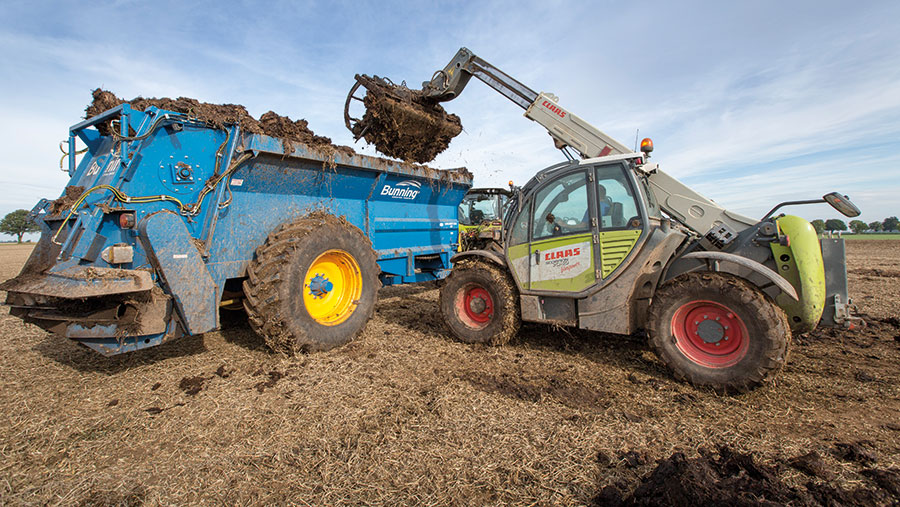How research project aims to improve phosphate use on farms
 Shane Rothwell © Gary Naylor
Shane Rothwell © Gary Naylor A research project investigating the role of phosphorus (P) within the UK food system has identified huge inefficiencies in its use, with a total of 138,000t of P unused, wasted or lost annually in 2018.
One of three key areas associated with this loss was the over-application of phosphorus, which sees a surplus of 90,000t of P applied to soils each year. That’s equivalent to an unnecessary 8kg/ha.
Phosphorus is an essential element in the food system. However, phosphate rock, from which fertilisers and feeds are derived is a finite resource, and only located in a handful of countries.
What’s more, leaching of P into watercourses can raise environmental concerns.
See also: How one Yorkshire direct-driller is tackling a drainage problem
The study
The project known as “RePhoKUs” aims to refocus phosphorus use in the UK food system to safeguard the future of food and water security.
Researcher Shane Rothwell of Lancaster University notes: “UK agriculture is entirely reliant on imports from countries such as Russia and Morocco.
“This means managing these reserves is crucially important, particularly when it comes to avoiding losses which can lead to nutrient pollution and eutrophication.”
The project involved mapping phosphorus use in the UK food system via a substance flow analysis. This assessed the imports, flows, stocks, losses and exports of P on a national, regional and catchment scale.
Working on the theoretic basis of mass balance, what goes in to a defined system must come out, as phosphorus cannot be created or destroyed.
The study identified three key areas of inefficiency at the UK scale:
- Over-application of P (90,000t)
- Loss to water (26,000t)
- Loss to landfill (22,000t).
“A total of 138,000t of phosphorus is wasted each year. That’s equivalent to 75% of total food system P imported into the UK, so there is considerable scope for improvement,” says Dr Rothwell.
As uncertainty rises across the globe, a future scarcity or a rise in import costs, could leave the UK food sector vulnerable.
Improving P efficiency would therefore increase the UK’s resilience by reducing reliance on imports and optimising the intensification of agriculture, while minimising impact on water quality, he explains.
Manures and regional P balance
One way of enhancing this is via the improved management of livestock manures, which is the route of the largest flow of phosphorus in to the UK food system (175,000t).
Livestock manures are also the largest contributor to soil surplus P.
In the West of the country where livestock dominates, the P surplus is greater, while in the East where cropping dominates, the surplus is lower and in some cases in decline.
The North West experiences the greatest surplus at 13.5kg/ha per year which is mainly a slurry management issue, while the East has a soil deficit of -3.2kg/ha per year.
“Where there is a P deficit, this cannot continue sustainably over the long term and will eventually lead to a yield penalty.
“The main driver behind the high surplus associated through livestock manures is a result of high levels of phosphorus in feedstuff such as soya and concentrate feed,” says Dr Rothwell.
He says tailoring P inputs to where they are needed across the UK would greatly improve efficiency and help improve this balance.
However, this comes with large logistical barriers and financial issues associated with the transport of manures from one end of the country to the other.
Recovery of fertiliser-grade P from manures to overcome transport barriers would help resolve the issue. How will this be achieved? Who will pay for it?
Grass versus tillage
Significant differences are noted when it comes to soil P use efficiency and cropping type.
Arable land under tillage is highly efficient, utilising 85% of phosphorus applied. This means it accounts for 15% of the national P surplus, the equivalent of 2.8kg/ha.
In contrast, grasslands receive most P in the form of manure and are only 53% efficient. This contributes 85% of the national P surplus, which equates to 11kg/ha.
Legacy soil phosphate

© Kirsty Forber
Shane Rothwell (above) believes finding ways to access the huge reserves of surplus phosphorus that lie in soils, known as legacy P, could prove critical to reducing reliance on phosphorus applications and optimising crop nutrient requirements.
“Due to the continued appliance of phosphorus, a huge reserve has accumulated over time, strongly bound in calcium, iron and aluminium complexes in the soil.
“The total amount of phosphorus available, therefore, doesn’t reflect what growers can access. Olsen P is used as the UK’s soil fertility indicator and in reality, this is only a small fraction of total P reserves,” he says.
Certain methods such as zero and min-till may increase the availability of P in soil, but the exact science behind this is unknown.
It is thought that as soil biology becomes more active, their biological processes make P more available.
Intercropping and growing legume crops are also thought to help, but more research is required.
P drawdown trial
An accelerated P drawdown trial was set up in a lab to identify if legacy P could be used by crops, when no other sources of P were applied.
A rapid growing ryegrass species was grown in pots containing soils from three catchment areas: The Wye (arable farm, Herefordshire), Upper Welland (arable farm, Leicestershire) and Upper Bann (dairy farm, Northern Ireland).
Over 535 growing days and 20 harvests, the trialists monitored biomass production, grass tissue P, soil Olsen P and pore water P.
Crop deficiency was generally found to take place at an Olsen P index of 1.
The amount of legacy P was calculated and as each cut of grass was made, additional P was taken up, highlighting in times of Olsen P deficit, legacy P can be used.
The cumulative P offtake and Olsen drawdown relationship was scaled up from “pot to field” to estimate legacy P for three different farms and suggested legacy P could keep crops sufficient in P for anywhere between two and 20 years depending on soil P status.
All about phosphorus
Phosphate leaches into water via surface run-off, mobilisation of dispersive soil, and incidental losses such as heavy rain after application.
However, the chemical properties of soils can have a significant impact on the capacity of a soil to absorb and hold phosphorus.
As researcher Shane Rothwell explains, if you think of soils as a sponge they are affected by three main factors:
- The size of the sponge
- How full the sponge is
- Ability of P to stay within the sponge
Soils with “leaky” sponges may be at more risk of pollution if they contain too much surplus phosphorus. As a result, legislation focusing on methods to reduce surface run-off and incidental losses alone may not address potential P losses in the long term and individual catchment areas and soil type need to be considered.
“What we need is good quality farming to draw down excessive phosphorus reserves to optimal levels in those areas, and then once this has been achieved we can maintain levels to achieve a sustainable use of P,” he says.
Regional and catchment level nutrient planning is also required to better manage local phosphorus surpluses from manure production.
The RePhoKUs project is funded under the government’s Food Security Research programme and is a collaboration between Lancaster University, the University of Leeds, Agri-Food and Biosciences Institute, University of Technology Sydney, UK Centre for Ecology and Hydrology, and the N8 AgriFood Programme.

